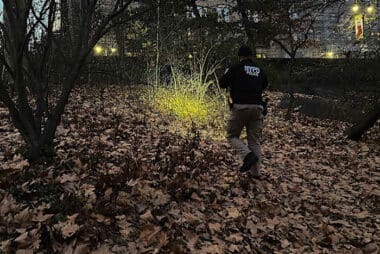As New York authorities deepen their investigation into the high-profile murder of CEO Brian Thompson, they grapple with a challenging paradox: a wealth of leads and yet a lack of identifiable suspects. The incident has captured public attention as both police and federal agencies mobilize substantial resources across multiple states in pursuit of justice.
Surveillance footage has become pivotal in retracing the gunman’s path. Images show the suspect, who appears to have left New York City by bus shortly after the shooting. Enhanced video capabilities have allowed law enforcement to pinpoint his movements, yet the individual remains unidentified despite the availability of facial imagery.
The incident unfolded with Thompson being ambushed early on Wednesday morning near the New York Hilton Midtown, as he arrived for his company’s investor conference. The attacker reportedly used a 9 mm pistol, previously seen in quieter settings such as farms, which speaks to a premeditated and calculated act.
Mayor Eric Adams commented on the state of the investigation, saying, ‘The net is tightening,’ as searches in Central Park revealed a critical piece of evidence: the suspect’s backpack. Furthermore, traces of ammunition found nearby included unusual inscriptions, potentially signaling a connection to broader criticisms within the insurance industry.
Despite the steady accumulation of clues, police have yet to apprehend the suspect, known to have utilized false identification and to communicate minimally, always masked with brief unguarded moments. The revelation of his unmasked images provided some hope of establishing his identity, although limitations related to facial recognition have impeded progress.
Police divers have scoured the intended escape route in Central Park, and while the discarded backpack could prove insightful, its contents have yet to yield a breakthrough. The public’s involvement continues to be sought, incentivized by substantial financial rewards for information leading to an arrest.
Complicating the investigations are fingerprints found at a nearby cafe, tied to a purchase shortly before the shooting. Yet these, too, have offered limited utility in narrowing down suspects. As such, detectives have urged patience, stressing that meticulous examination of all evidence takes precedence over a hastily concluded inquiry.
Police have corroborated that the gunman was in the city ten days before the assassination, living in obscurity at a hostel and using cash for transactions to avoid detection. Given these details, the suspect’s familiarity with Thompson’s itinerary suggests a deeply personal motive, potentially pointing to prior grievances. Thus, investigators consider the possibility that the attacker might be a former associate or a discontent individual connected to corporate dealings.
Despite the technological advances at their disposal, law enforcement faces hurdles in identifying how or when the suspect left the metropolitan area. Nevertheless, Police Commissioner Jessica Tisch remains resolute, affirming belief that the suspect has exited the city and detailing ongoing efforts to locate him.
The relentless pursuit of the individual responsible for Brian Thompson’s death underscores the complexities of modern criminal investigations. As police continue their exhaustive search across state lines, they exercise caution and diligence. Although the suspect remains elusive, the collective resolve of the investigative teams remains unshaken, reflecting their dedication to delivering justice and closure.
Source: News4jax












